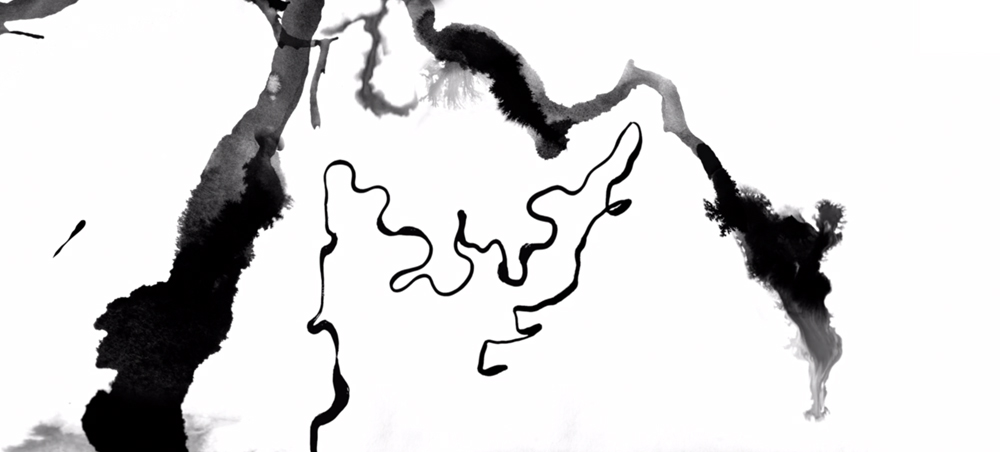Animation from the Block
On the last weekend of July, in Fort Green, Brooklyn, NY, lies the Animation Block Party. It’s a four day animation film festival, hosted mainly by the Brooklyn Academy of Music, that I’ve always associated with a source of cutting edge ‘cool flicks.’ In the last several years however it has matured, having just celebrating its 10 year anniversary. The festival, founded by Casey Safron, has now become not only an excellent source of international animation, but also of historical film and experimental theatre.
Opening Night
Heaving off old traditions and stretching out a new form, Animation Block Party did not open its festival at the usual Automotive High School in McCarren Park, Williamsburg, on Thursday night. Instead, ABP traded its grass lawn and roadside traffic for a vast concrete plaza and riverside view of New Jersey’s Powerhouse Art District, at Brookfield Place (formerly the World Financial Center), in TriangleBelowCanalSt Manhattan. Presented by Rooftop Films and Arts Brookfield, gates opened at 6:30, and the seated section in front of an inflatable screen filled quickly. About an hour later there was some live indiepop (electro-punk) music by Franny & Zooey, a Domican-Republic/Bronx band with a penchant for 1960s American literature. Behind the plastic seating area was a ‘picnic’ area, but I think you would need some serious blankets to get comfy. The entire public space was masterfully redesigned after 9/11 to provide many surprisingly comfortable steps, blocks and benches. As the sun set and a cooling breeze rocked sailboats in the harbor, Animation Block Party began.
This year’s ABP Intro was Street Justice by Ben Li (Burbank). A crime fighting drama ramped up the audience for something… something exciting and vaguely menacing as the intro ended with an extreme hero shot and our two male and female protagonists looked down at us, lying on the ground. It had a hand drawn, comic book anime style, and cut to simple white text on black: “Animation Block Party 2014.” 🙂 Love Ball: Ball on FIRE by Dana Sink (Pennsylvania) made a triumphant return. This is a sequel to Love Ball which was screened at ABP last year, and involves a colored pencil marble run, through complicated still backgrounds, with the addition of an evil claw machine and some trite “wife and baby” balls. I was already starting to enjoy this sequel more when the marble ran through a sinister set of spikes and grey balloons gently fell to their destruction. It conjured a feeling of danger and risk in the scenery, without any Hollywood tropes. Goodbye Rabbit, Hop Hop by Caleb Wood (Minnesota) is a hallucinogenic experience of chasing a bunny in the woods, with flowers and the camera constantly quavering in a way that needs to be repeated more often in animation.
The highlight of the night (and in my opinion, the festival) was Le Sens Du Toucher by Jean-Charles Mbotti Malolo (France). It told the story of a young deaf couple having a romantic dinner date at home, the dangers of cat allergies, and of driving angry on winter roads. Not satisfied to convey the deaf importance of touch through hand drawn animation, Malolo also used his background as a professional hip-hop artist to add dance to his film. Even though the Q&A was unexpectedly canceled, I managed to speak to Malolo and he said that he had directed several members of the dance studio he was in, to create live-action reference videos. In the film, the man and woman pushed, pulled, and rolled their way through a pas-de-deux that impressed me in its weight and resistance. It struck a chord in me that I haven’t thought of since watching hip hop in So You Think You Can Dance while I was still taking ballet classes.
Finally, Papa by Natalie LaBarre (School of Visual Arts) ended the evening with a charming tale about a single father inventor and his daughter. This eventual Audience Favorite Award had computer drawn character designs that were simple and charming enough to pull on everyone’s heartstrings.
On Friday at BAM! were the Experimental/GraphicDesign/MusicVideo program and the Student/Independent program. These were held in the afternoon, so I was unfortunately at work editing some corporate bank videos at the time. You can find a list of all of the films in the festival here. The big feature film screening shown on Friday night and Sunday afternoon was SPACE JAM! I respectfully hooted every time someone mentioned SPACE JAM! but I’m pretty sure I have a $5 DVD of it, so I did not attend. Later that evening was Animation Breakdown Roundup “Cinefamily’s resident home for mind-expanding animation!” and a non profit based out of Los Angeles, CA. Kevin Sukho Lee (Nickelodeon) and Alex McDonald (Cinefamily) were in attendance to introduce the films. Almost every film in the screening was epic.
Mondo Taurobolium by Galen Pehrson is a James Dean Mullholland Drive tale of duck-actors dragging themselves through a pointless yet comfortable existence, in hand drawn muted color. Its My Beak by Seth Cooper is another hand drawn duck film, with an electric rainbow of EDM club ducks ducking it out, dancing in the style of everyone you know and love or hate. One of the most powerful films was Eager by Allison Schulnik. A stop motion masterpiece, its overture was of a choreographed pulse by three wraith women, occupying only the lower third of the pitch black stage. From there bloomed (literally) a grotesquerie of flowers and culminating in a forest.
The after-party was held at Pacific Standard, with a dollar off all drinks for ticket-holders, and more paper and slick calligraphy pens than you could shake a peg-bar at. ABP’s audience soon claimed the back area and spread out over tables and comfy couches to illustrate and drink. As always, many notable film makers were in attendance; for example Leah Shore (Old Man, Eat Cake). She sported what I will call a spectacular Minnie Mouse hair-do.
Getting to the Kids program on Saturday afternoon ended up proving to be a little more difficult than expected, since I had already stayed up way too late block-partying for the last two nights. I missed twenty minutes, but came in time to learn that P is for Pineapple!!! The Goldfish Kite by Juliana Chen (Maryland Institute College of Art) almost made me cry with its ridiculous tale about a happy boy and his slightly-worn kite friend. No dialogue, all digital paint. Floating In My Mind by Hélène Leroux (Gobelins) is hand drawn, and told one boy’s life story, by carrying around balloons as metaphor. She managed to sneak in a questionable balloon inhalation stoner joke (there’s nothing like hearing 30 odd Park Slope parents gasp in unison).
Farmer Alfalfa
Next up was Tom Stathes’ Cartoons on Film, presenting a Farmer Alfalfa retrospective. Farmer Alfalfa is an American cartoon character who first appeared in 1915 and was created by Paul Terry. A variety of shorts (from 1915 to 1946) were shown about this grizzly old farmer rube, who battled with sassy farm animals everyday and got into racy shenanigans at the beach and the big city. Afterwards there was a Q&A with Tom Stathes (moderator, a historian with a specialty in 16mm 20th century American animation), David Gerstein (animation researcher, “The Floyd Gottfredson Library”), Charlie Judkins (a writer currently chronicling Paul Terry’s life), and Thad Komorowski (author Sick Little Monkeys: The Unauthorized Ren & Stimpy Story) [T.K. made a fine replacement for Howard Beckerman, who withdrew from the panel a few days beforehand].
Paul Terry grew up in San Francisco and his father sold fire-insurance. Paul started work at the newspaper The San Francisco Call correction Bulletin, and got his first big story by photographing a big (Montana?) fire in 1904 correction: San Francisco fire in 1906. The inspiration for the bearded straw-hatted rube with glasses came from Paul’s older brother John. John also worked as a cartoonist at the same newspaper, and Paul was heavily influenced by copying his comic style. The two brothers had a “lightning sketch” vaudeville act where they would sketch on big sheets of paper in front of an audience. Around 1911 Paul Terry moved to NYC.

Farmer Alfalfa in Barnyard Artists (Hugh Shields, Aesop’s Fables Studio / 1928) (credit: Stathes Collection, but I edited to pretend its 70mm LOL)
There are over 450 Farmer Alfalfa cartoons from the silent film era, and about 150 more from the early age of sound. The farmer served as a foil for many animal characters who would play mean-spirited jokes on him. Baby-Boomers know and love Farmer Alfalfa from early B&W television, where he was also known as Farmer Greg on certain stations. Tom Stathes says that many kids saw him as “the Second Coming” – so devoted were his fans. Farmer Alfalfa’s cat companion was named Henry the Cat, until a newspaper contest renamed him Waffles (I assume he kept his surname).
Farmer Alfalfa has a long history jumping from studio to studio. In 1920 Paul Terry (after closing his own studios to serve in WWI) partnered with Amadee J. Van Beuren and formed Fables Studios. Van Beuren put on the pressure to use the new technology of sound. Soon the Alfalfa cartoons were no longer cranked out at the rate of one-per-week; in fact, the cost of sound production, “not to mention Terry’s tight-fisted production style,” (~ Charlie Judkins) caused several lay-offs. A sharp-eyed audience member asked if the films had a variable-density or a variable-area soundtrack (trick question: it was half density… although I admit I didn’t follow why). Much of the music for the silent shorts, such as Custard Pies, was later added for TV syndication, and Dinner Time was produced with sound a whole two months before Disney’s Steamboat Willie.
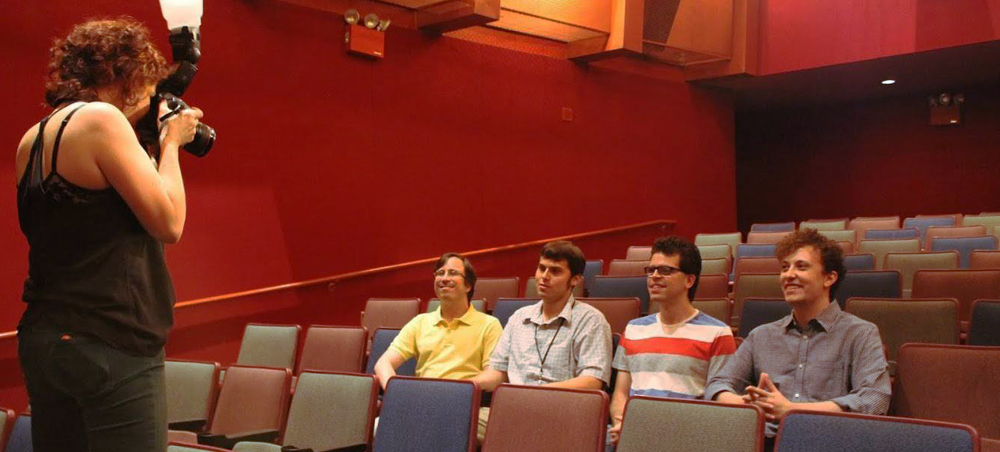
David Gerstein, Thad Komorowski, Tommy Jose Stathes, and Charlie Judkins getting some press attention at the Farmer Alfalfa screening. (photo by Joel Esquite)
In the New York City area, Farmer Alfalfa finally went off the air in the 1960s. The show lasted until the ’70s in Puerto Rico. One of the films, The Talking Magpies was retrofitted to be a Heckle & Jeckle film, since producers later decided the birds were a precursor to the more famous twin characters. The screening had several interstitials that were created in the 1960s for TV, by retracing Farmer Alfalfa’s Birthday Party (1932). All of the films shown were HD Digital Transfers of 16 mm prints, from Tom Stathes’ collection. Scanning can be done in real time by special machinery as the films plays. There were not many remaining negatives for Tom’s collection, so his restoration comes mainly from finding the best copy of a film available. He does not spend too much time in post-production adjusting color levels, which can easily lose gradation. The classic cartoons have had a vast impact on children all over the world and over decades. There is even an arcade machine about ol’ Alfie in Japan. Today Farmer AlfaAlfa is owned by CBS, and in turn by correction: Today, the Farmer Alfalfa character, but not the films, is owned by Viacom, who, the guests joked, probably isn’t even aware that they own it.
In the evening, I refueled at my favorite festival hangout spot, the Italian restaurant Scopello. You can score a gourmet panini and salad for $11 and a glass of Malbec for $10. It is very nicely decked out at the bar, on the sidewalk, and in the back table area. The new bartender was practicing drinks. I would recommend a Mary Pickford cocktail: Barcardi 151, pineapple juice, grenadine and maraschino. “Sweet with a real kick, just like it’s namesake!”
Part 1 of the International shorts program screened on Friday night. Fol’Amor by Gobelins was our first film: a 3d CGI medieval romp in which a dorky knight woos a busty lady. She requires feats of valor for her heaving breasts, and certainly knows how to encourage her wooer into acts of strength. The climax of the film is something else. (It was around this time that I noticed that the projector’s whites had turned slightly blown out). Man On The Chair by Dahee Jeong (France) is an interesting hand drawn film about a man experiencing an existential crisis. It featured very creative framing, staging and perspective that only heightened this point. The poor man is left wondering if he is an animation. I shudder to mention Obvious Child by Stephen Irwin (UK) a cutout puppet style horror that dealt with the bitterness and crushing despair of the uselessness of death and Heaven, with copious amounts of blood. Blegh!
For the final Friday screening I prepared for an emotional roller coaster: Titmouse’s Best of 5-Second Day. Titmouse, an animation studio with offices in NY, LA, and Canada, started a new exercise in which its animators get a day off from their regular projects, to create at least 5 seconds of any animation they want. The idea was usually taken earnestly in stride, with only a few people being too cool for school. There was a lot going on, but in general I remember: kitten, ninjas, things running around, and a great boob joke. There were lots of individual styles, but I think my favorite was Big Black Robot, which featured a lot of cool slang that I can’t remember and probably shouldn’t use anyway. A lot of animators took time for an intro, and most of them had an arc, although a few just chopped the end. The average length was probably 45-60 seconds. My friend Pilar liked Chasing Sunlight by Alex Kwan, where a little seed person raises a family while walking through the forest, and my friend Emmett enjoyed Star Crossed Lovers by Allison Craig which illustrated a sad love triangle between the earth, moon, and sun.
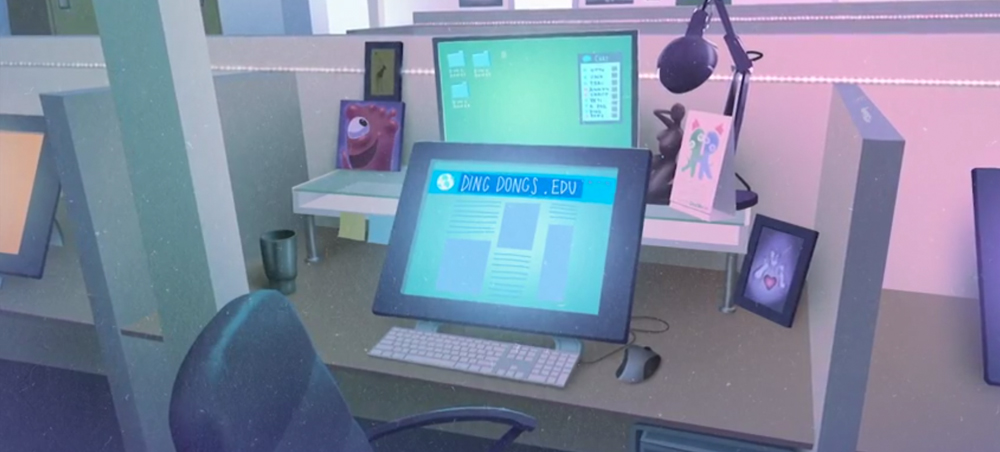
Titillating Tales by Teri Cusumano (Best of 5 Second Day: showing a sneak peak at the studio)
ABP canceled the Sunday night after-party and threw the big bucks behind S-A-T-U-R-D-A-Y… NIGHT! At the new BAM Fisher building, we were treated to free wine and beer in the basement area, along with the most pleasant, magical doughnuts from Doughnut Plant. (Seriously delicious, should have put some in my bag.) On the ground floor there was a great club space decked out with laser lights and a nice DJ. There was air hockey, foozball, ping pong, Back to the Future pinball, and more. The biggest hit of the night was the drawing art wall, sponsored by Sakura Art supplies, which provided the nicest markers imaginable. There were tables set up everywhere with more crayons and paper, and there was ZERO dancing and 100% drawing. People were just sitting around (wallflower style) taking a look at awesome animation loops from LoopDeLoop (a bi-monthly animation challenge), while different colors cascaded over their faces and the UNTZ UNTZ of the music made them rock slightly.
A bunch of animators sat around and tried to play the Exquisite Corpse game, but it was a little bit too free and fancy with the rules for my taste, and I only saw two pieces completed successfully. Another group tried the game where you write one sentence, pass it to a friend, and they draw that sentence. Then that person passes it to the next guy and they have to write a sentence that they think the drawing was based on. Unfortunately the paper was cut up incorrectly, so there was a lack of continuity. I did have to help someone identify “balls to the wall.” Over all it was a great evening, that ended up on the rooftop bar of Fisher, where animators made new friends and debated the animations they had seen so far.
The John Hubley Centennial
In the dark of the John Hubley Centennial screening, a little kid behind me starts to breathe heavily. Her concerned mother asks if she is cold. The girl’s reply? “I’m freezing but if I put my sweater on, I’m afraid I’ll MISS something.” Adorable! Everybody was delighted. One of the highlights of this year’s festival, this program included 8 shorts by John Hubley, from 1956-1970. It was a dynamic juxtaposition of his children’s stories (usually featuring the voices of his own kids) and of his loftier works concerning life and death, war and peace. At NYU, my Professor John Canemaker had shown me my first Hubley short, and I caught several more at a previous MoMA interview Canemaker had with Emily Hubley (the daughter of the original husband and wife animation team).
On this day, I saw The Hat (1964) for the first time, and was thrown for a small loop by the unexpected accents of the voices. John Hubley didn’t take the easy route with a Russian vs American characters. No, he used an African-(American?) and a British-countryside accent. The two soldiers marched through the winter woods, patrolling their sides of the line while arguing and pleasantly conversing about the inherent problems of their unique situation, while forest animals regarded them in puzzlement and hopped back and forth as they pleased. We later found out that the Hubley’s added hand drawn elements to recreate video scan lines.
Emily and Georgia Hubley were available for a Q&A with festival director Casey Safron. They told us how that their parents had met while working in California, and that one of their self imposed conditions of marriage would be to move to New York. [This proved to be an even more attractive option after John Hubley was blacklisted in 1952 and had to leave UPA Studios. While John refused to name names before the House Comittee of UnAmerican Activities, one woman in his circle was more easily persuaded and sang like Tweety. For more information the Hubley recommended the book Forbidden Animation by Karl Cohen. It also provides details on the Disney Strike, and how the mob decided to muscle in on the profitable early film industry.]
Once the newly wed couple arrived in New York, they found it much easier to express their creative independent voices. In 1960 John Hubley helped form the Association Internationale du Film d’Animation (ASIFA) itself! (Remind me to update his wiki page).
Emily and Georgia Hubley admitted that it is difficult to watch Windy Day since they had voiced it, as well as Moonbird which was voiced by their brothers. Both shorts had their audio created by directed-improv sessions with their parents, with John sometimes play acting as the bird during the recording. As a reward for good behavior (and acting, one might hope) the kids were given special treats of milkshakes. Georgia would help direct her younger (?) sister Emily in the sound booth, which is why the dialogue sometimes sounds more like prompts than kids’ play.While the Hubley’s were animating Windy Day they realized they needed a more definitive ending and went back to record a few months later. But by then, they said, the girls had developed more of a self-conscious attitude and could only really laugh and giggle. Regardless, throughout the process Faith interviewed her daughters personally and was able to score great quotes about death and where babies come from. While the daughters re-watched the films, they noticed that there were a lot of sight gags especially crafted by John to fit around the dialogue.
John and Faith Hubley were very well read, and living in 1960s New York only heightened their interest in socio-political issues. When they liked a particular book or idea, they pressed the author for a collaboration, leading to great films such as Everybody Rides the Carousel (1976) based on Erick Erickson‘s books on themes of psycho-social development, and Of Stars and Men, based on Harlow Shapley‘s book of the same name. The Hubley’s wanted to publicize the works, and fought to convince people that animation was a serious art form that could spread ideas across boundaries.
The last programs of the evening included Narrative/Studio/Local Shorts and the second half of International Animation. Gunther by Erick Oh (California) is a great short depicting a fun community of animals, plants, and food who live in a blank white space. They try to eat each other and themselves without impunity, and with infinite forgiveness. This is top quality slapstick, which is not surprising seeing as how many Pixar artists were involved in the creation of the film. Junior’s World by Alex Cline (California) is a creepy film in which a new dad has to come to grips with the fact that his baby son is a puppet. Yearbook by Bernardo Britto (New York and Miami) is a great story about one man’s quest to transcribe human history in the 17 years before an alien missile wipes us all out.
Confusion Thru Sand by Ornana Films, Danny Madden (CA and NY) is an epic war film, depicting one soldier’s mission into the blazing Middle East facing unknown dangers of a foreign land, the plight of poor farmers, and the treachery of dust. It is unclear whether or not he survives, succeeds, or knows what he is doing. Winning Best Narrative short, it was made with black markers on 100% recycled paper, but I regret not seeing a full HD version, with the sand blowing through, as the storms inevitably turned out pixelated.
Virtuos Virtuell by Thomas Stellmach and Maja Oschmann (Germany) is a spectacular abstract inkblot film, with black ink on pure white, set to the overture of The Alchemist by early German romanticism composer Louis Spohr (1784-1859). For something completely different, Poils/Hair Delphine Hermans (Belgium) is an intimate digital cartoon look at the sexuality of body hair: its removal and growth. One of the final films was Padre (Santiago Bou Grasso (Argentina, France), a 3d CGI film which captures the plight of family in Argentina after a massive police corruption scandal takes many lives, and of those who are left behind who are ruled by time, fear, and loneliness.
Animation Block Party started in 2004, opened to international shorts in 2005 and expanded to a long weekend in 2006. Each year it continues to provide a bounty of intriguing animation and it is a great opportunity for talented animators. A weekend pass is $106.50 and comes with a free DVD (which is now an out of print collectible item). Thank you to Casey Safron and all of this year’s artists who helped make such a wonderful weekend! See you next year.
~ Tristian Goik

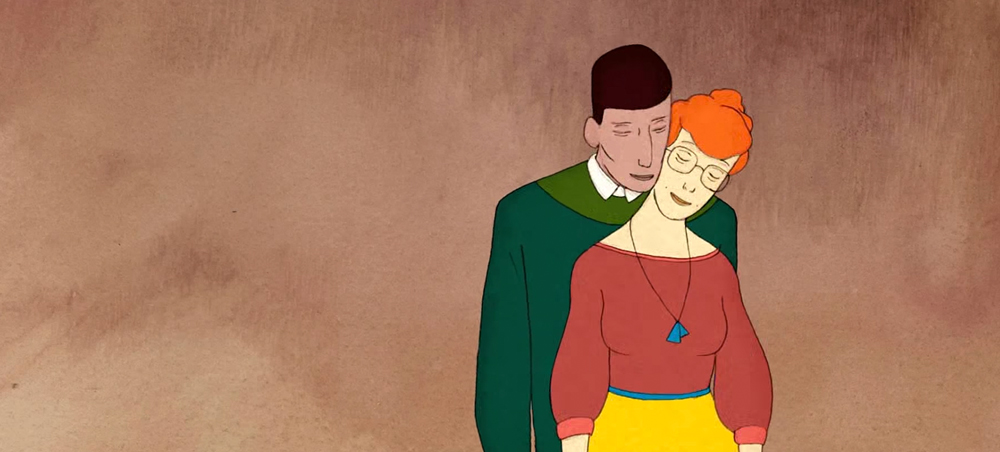
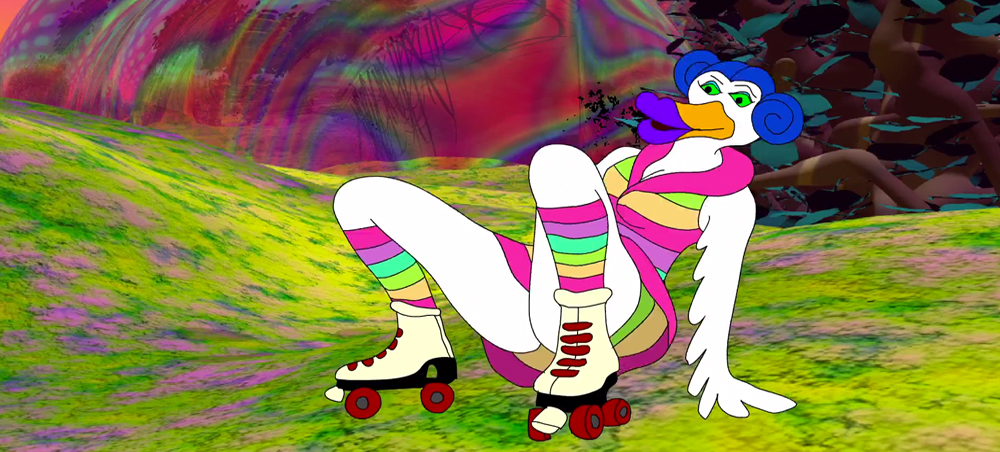

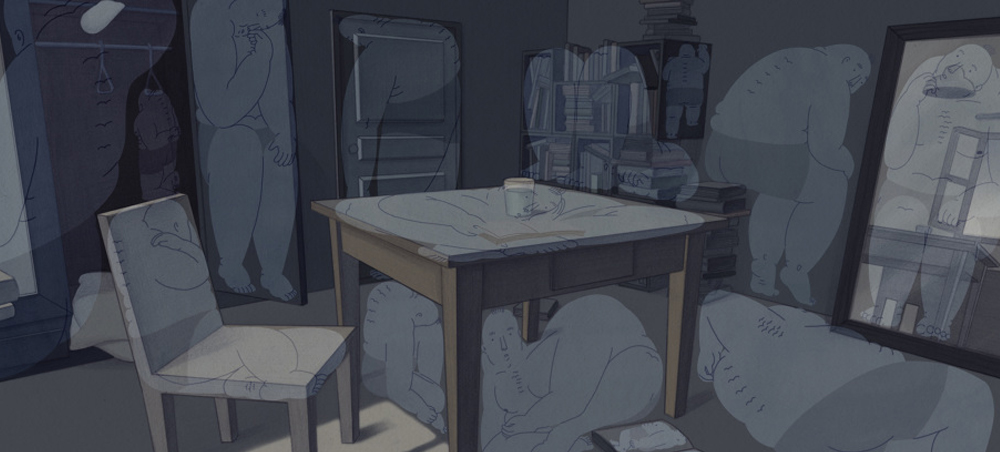


![The Hat by John Hubley (1964) [photo credit :artistspublicdomain.org]](https://asifaeast.com/wp-content/uploads/2014/08/thehat.jpg)

